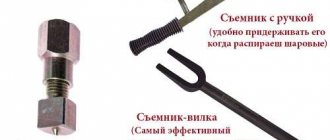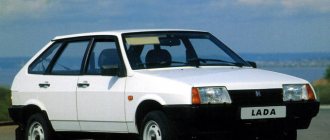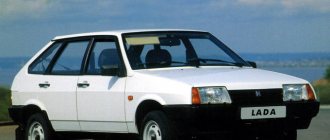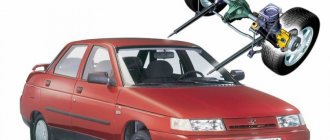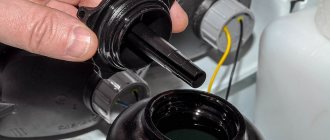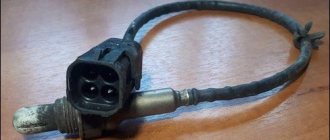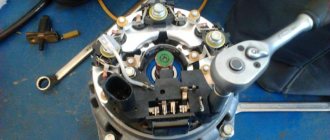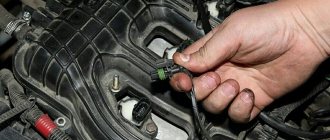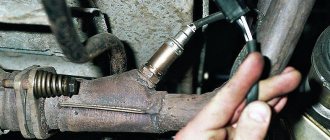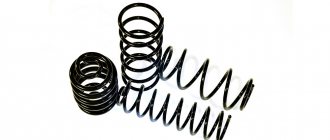The ball joint is one of the most important components of the front suspension of front-wheel drive cars, including the Lada Kalina. The main purpose of the ball joint is to be the connecting link between the steering wheel hub and the suspension arms. That is, during vertical movement, the hub rotates, but the horizontal position of the wheel remains unchanged. The condition of the ball joint should be carefully monitored. Otherwise, there is a high probability of serious consequences, especially if the breakdown occurs while driving. If the ball joint fails, the wheel will turn outward and the car is guaranteed to fall onto the wing. If you imagine such a situation at high speed, there is a high probability that its development will lead to a serious accident.
Characteristics of the ball joint on the Lada Kalina
This unit holds the wheel in a certain position, while at the same time allowing the hub to rotate and maintain horizontal stability. The ball joint is called because of the ball-shaped tip. Structurally, it is a cone-shaped unit.
The Lada Kalina uses a modern collapsible element, although the first VAZ models had stamped assemblies from several parts, and then cast structures. The ball joint installed on a Lada Kalina car, regardless of modification and generation, has a standard device that includes several main components:
- frame;
- a part in the form of a cone (another name is “finger”);
- rubber protective boot (prevents dirt and dust from entering).
The main elements are made of high quality steel. This is due to the fact that during operation the working parts are constantly exposed to load, friction and, as a result, high temperatures. The only exception is the hollow part of the body, which is covered with polymer materials. Plastic is mainly used for these purposes.
The main advantage of the Kalina ball joint is the extreme simplicity and efficiency of the design, which allows the contacting parts to move freely at equal angles.
Looking at the structure of the ball in more detail, it can be noted that it is actually a steel finger, which on one side ends with a tip in the form of a small ball. The tip rests on a plastic (or polyurethane) gasket. The bushing and ball end are located in the body and are rolled to prevent flyout. The body is additionally galvanized against corrosion. It is fixed to the upper or lower control arm and the threaded part is secured with a knuckle nut. Thanks to this, the fist is not fixed too tightly, which allows it to rotate along with the wheel hub, and the vertical position is maintained when the vehicle’s suspension is operating.
The ball joint is a fairly reliable and durable unit if you follow the operating rules. The long service life of the ball joint is possible thanks to the lubricant located in the part of the housing where it comes into contact with the working part. Insufficient lubrication, its leakage and moisture entering the internal cavity can cause premature failure of the entire assembly. To protect the working parts, a special boot made of rubber that is resistant to aggressive environments is used.
In order for the ball joint to last as long as possible, every car enthusiast should check the condition of the suspension from time to time, paying special attention to the rubber boots. There should be no cracks or other visible damage on their surface. If there are defects, it is recommended to check the condition of the entire assembly for wear.
Diagnostics of ball joints on VAZ 2101-VAZ 2107
Welcome! Ball joints are a very important element of the front suspension, this is especially true for VAZ classic cars. There are twice as many ball joints there as in front-wheel drive cars (4 pieces), due to which the car becomes more dangerous. After all, if you don’t take care and drive a car whose ball joints have failed, the wheel may simply fall on its side. If you drive at this time, the car will immediately lose control and it will be very, very difficult to stop it. We would like to show you a striking example in the video below, where the ball joint fails and the right wheel of the car simply falls on its side.
Note! To diagnose ball joints, you will need a mount or a mounting blade or a crowbar; In addition, you will need a very thin stick, either metal or just a twig, but, very importantly, the stick should be smooth, without bends or the like. (It is best to use a 5.6 cm long metal stick). And besides all this, you will also need a ruler and a small knife. Or instead of a stick, ruler and knife, take a good caliper that will replace all these tools!
When is it necessary to diagnose ball joints?
It all depends on the area where the car is used. If you operate it in very large cities (such as Moscow), in the very center of the city, mostly on ideal roads, or in St. Petersburg, where the roads are clearly not inferior, then you don’t even have to bother with diagnosing the suspension. Just look there once a year or every 100,000 km, check everything and move on. But, basically, Lada cars are used in small towns, villages and similar places where the roads, as they say, leave much to be desired. In this case, diagnostics of the entire suspension as a whole, as well as diagnostics of ball joints, should be performed as often as possible, approximately once every 20,000 km. Or after a good collision into a deep hole at speed. This way, you will always be confident in your car and will not be afraid to use it, since after a thorough check you will know with high accuracy that the suspension is fully operational.
Diagnostics of ball joints and reasons for their failure
Like all budget front-wheel drive cars, the Lada Kalina is equipped with a MacPherson-type front suspension. Briefly, the design consists of an upper support in the form of a strut with a shock absorber and a spring, and a lower support in the form of a wishbone. This lever is connected to the wheel hub (via the steering knuckle) using a ball joint. The design is elementary and therefore reliable, but the presence of moving elements makes diagnostics a difficult task, requiring certain skills and knowledge.
Signs of a ball joint malfunction
The most common symptoms of problems with this unit include the following:
- when driving at low speed over uneven surfaces, a knock is heard from the front suspension;
- when turning the steering wheel, a slightly greater force is required;
- when turning the steering wheel, the front suspension begins to creak;
- Tires wear out differently;
- The car pulls to the side when driving in a straight line.
But it is impossible to diagnose only a ball joint based on these signs, since these same symptoms may indicate problems with the shock absorber strut, wheel bearing or suspension arms. There are a number of methods for independently identifying faults that are not very complicated.
Options
Performance
It should be taken into account that on non-original supports there are special diagnostic holes that allow you to determine how worn the tip is. In addition, you can find out about problems with the ball by looking at the condition of the protective boot. Even small cracks can cause grease to leak and dirt and dust to enter. As a result, this results in accelerated wear of the unit and a significant reduction in service life.
Selection of ball joints for Lada Kalina
Its front suspension is not much different from previous VAZ models, for example, Priora, Samara, etc. The chassis of different generations of Kalina itself does not stand out fundamentally. On the first generation and on Lada Kalina cars of 2 different modifications, ball joints with catalog number 21100-2904192-82 are installed, and for supports with a set of fasteners, catalog number 21100-2904192-86.
The modern auto parts market offers customers different types of supports. The first are original (welded from several parts), and the second are stamped and reinforced. Structurally, all these hinges are arranged identically. The only differences are in the manufacturing technology and quality of the steel used, as well as its thickness. This determines the strength of the products, their durability and, of course, cost. In terms of size and principle of operation, they are no different from each other. From this we can conclude that the question of choice is not fundamental and depends on the personal preferences of the car owner.
Experienced car enthusiasts, as well as auto mechanics, recommend using exclusively original components. Only by choosing the original, you can be guaranteed to obtain the declared quality, reliability and long service life. However, as practice shows, original spare parts are sometimes much more expensive than analogues, so most car enthusiasts prefer to use the second option.
When choosing analogues, you need to approach the issue carefully and responsibly. You should not choose very cheap spare parts from an unknown manufacturer, and you should also not take components from markets, unknown points, or simply from your hands. Before purchasing, you should carefully inspect the components. There should be no visible welds on them; the surface should be gray, which indicates heat treatment of the part.
The components must have an emblem and a quality mark. As a rule, fakes do not have this.
Indirectly, quality is indicated by holograms on the case or packaging of components, as well as an additional set of fasteners. The cost of a ball joint for Kalina usually does not exceed 500 rubles. It's inexpensive, but it's worth considering that purchasing units for tuning can be significantly more expensive. For example, those from Pasker are valued tens of times higher.
Choosing the right new ball joints
The chassis of Lada Kalina cars of both generations (models 1117, 1118, 1119, 2192 and 2194) is built on a complete base, which is for the most part unified with earlier and later cars of the Volzhsky Automobile Plant. In particular, all Kalinas are equipped with the same ball joints that were used on the Samara family (VAZ-2108, 2109, 21099) and Samara 2 (VAZ-2113, 2114 and 2115), Lada 110 (VAZ- 2110, 2111, 2112), as well as on the current Priora and Granta models.
Ball joints for these model series have the original catalog number 21100-2904192-82, the same supports complete with fasteners have the number 21100-2904192-86.
Moreover, today the market offers two modifications of ball joints - standard welded and reinforced stamped ones. Hinges differ in production technology and the thickness of the metal used, which affects their strength characteristics, durability and price, but their installation dimensions and characteristics are the same. Therefore, it’s up to you to decide which supports to buy for your car.
Replacing a ball joint on a Lada Kalina
The instructions for carrying out work on the first generation Lada Kalina and the “two” are no different. This does not depend on the modification, for example, sedan, station wagon or hatchback (cross). You can do everything yourself. To do this you will need the following set of tools:
- wrenches or socket heads 17 and 19;
- TORX E12 head;
- special puller for ball joints.
You may also need a torque wrench to ensure optimal tightening of nuts and bolts, a pry bar, and a hammer to knock out the pin. As for the TORX E12 key, it can become useful when working with a ball joint on Kalina 2, where this fastener is used for fastening to the steering knuckle, and not a 17 bolt, as on Kalina 1st generation.
Rules for removing the ball joint
Before starting work, you should raise the parking brake lever all the way and use the jack to hang the desired wheel. The further process is as follows.
- Using a socket or a 19 mm wrench, unscrew the fastening nut, thanks to which the ball end is mounted on the wishbone.
- Use a special puller to remove the conical pin from its seat in the body.
- Using a 17 wrench (on Kalina 2, a TORX wrench), unscrew the fastening bolts that secure the ball to the hub knuckle.
- Using a pry bar, lower the lever lower. This will give you access to remove the ball joint.
To make the task easier, you can pre-treat the bolts and nuts with VD 40 or any similar liquid. This is true in some cases, but usually there are no problems with unscrewing nuts and bolts. If there is no puller for ball joints, you can remove the pin in another way:
- loosen the nut and leave it on the tip;
- Use a mounting spatula to press the lever from top to bottom;
- Use a hammer to knock the pin out of the body, thereby pressing it out of the seat.
If desired, the ball can be visually inspected and tested for compliance. To do this, the assembly is clamped in a vice. And with movements in different directions, the axial and other play of the finger in the socket is checked. The play should not exceed 0.7 mm; if there are large deviations in this indicator, the unit should be replaced; the ball joint cannot be repaired. If it is in order, but the rubber boot is damaged, you can only get by by replacing it. To do this, the support is dismantled and the boot is removed from it; before installing the cover, it should be filled with a suitable lubricant and fixed to the support.
